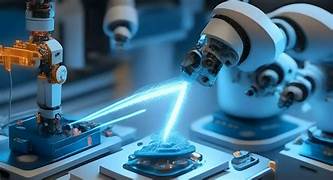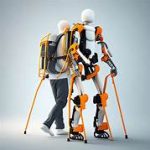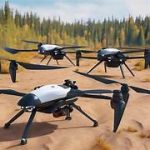AI-Powered Robotic Arms for Precision Manufacturing: Transforming the Future of Industry
The manufacturing sector has undergone numerous technological advancements over the years, and one of the most significant innovations in recent times is the rise of AI-powered robotic arms. These intelligent machines are revolutionizing precision manufacturing, bringing forth a new era of efficiency, accuracy, and flexibility. Combining robotics with artificial intelligence (AI), these systems not only perform repetitive tasks but also learn, adapt, and optimize processes in real time. This article will explore the transformative role of AI-powered robotic arms in precision manufacturing, examining how they work, their applications, benefits, challenges, and what the future holds for this technology.
Understanding AI-Powered Robotic Arms
At their core, AI-powered robotic arms are mechanical systems that perform complex tasks with a high degree of precision, guided by AI algorithms and advanced sensors. Unlike traditional robotic arms that follow simple pre-programmed instructions, AI-driven robots are capable of self-learning and adapting to changing environments. They use machine learning models, computer vision, and other AI techniques to process data, make decisions, and optimize their movements and actions.
The key components of AI-powered robotic arms include:
- Sensors: These sensors provide real-time data about the environment, the task being performed, and the object being manipulated. This allows the robotic arm to adjust its movements for maximum precision.
- AI Algorithms: Machine learning and deep learning models are used to analyze the data gathered from sensors. These algorithms help the arm make real-time decisions, learn from mistakes, and improve its performance over time.
- Actuators: These components drive the mechanical movement of the robotic arm, allowing it to perform physical actions like picking, placing, welding, or assembling parts.
- Connectivity: AI-powered robotic arms are often part of a larger connected system, communicating with other machines, devices, and even humans to ensure seamless operations and optimize manufacturing processes.
How AI Enhances Precision Manufacturing
AI enhances robotic arms in various ways, enabling them to perform tasks that were previously unimaginable in terms of precision and efficiency. These systems can:
- Adapt in Real-Time: AI-powered robotic arms are capable of adjusting their actions based on changes in the manufacturing environment. For example, if the position of an object shifts, the arm can automatically reorient itself to maintain accuracy.
- Improve Over Time: Through machine learning, these robotic arms improve their performance the more they are used. Over time, they learn from previous tasks and can adjust their strategies for greater efficiency and precision.
- Optimize Movements: AI can optimize the movements of robotic arms to reduce time and material waste, improving both productivity and cost-efficiency.
- Predictive Maintenance: AI algorithms can detect potential issues or failures in the robotic arm before they occur, ensuring that maintenance is performed proactively and reducing downtime.
Applications of AI-Powered Robotic Arms in Precision Manufacturing
AI-powered robotic arms are used across various industries to perform critical tasks with high precision. Some key applications include:
1. Assembly Line Automation
AI-powered robotic arms excel in assembly line environments where high-speed and high-precision work are required. These robots can assemble small and delicate components, such as microchips in electronics or intricate parts in automobiles. By performing these tasks autonomously, AI-driven robots help increase production speed, reduce human error, and maintain consistent quality.
2. Welding and Soldering
AI-powered robotic arms are particularly valuable in tasks like welding and soldering, where precision is crucial to ensure the structural integrity of a product. These robotic arms adjust their movements based on real-time data and feedback, ensuring that the welds or solder joints are applied with the perfect amount of pressure and at the correct angle. This leads to stronger, more reliable products.
3. Quality Control and Inspection
AI-powered robotic arms are equipped with advanced sensors and computer vision systems that enable them to detect defects in products that are often invisible to the human eye. These robots can identify flaws such as scratches, dents, or incorrect placements during the manufacturing process. By incorporating AI into quality control, manufacturers can ensure that only defect-free products reach the market.
4. Material Handling
AI-driven robotic arms are used in material handling applications to move raw materials, components, and finished products efficiently. These robots can sort, stack, and transport goods with precision, ensuring that the right materials are in the right place at the right time. AI allows these robots to navigate complex environments and adapt to changing conditions, reducing the risk of accidents and improving workflow efficiency.
5. Precision Machining
In industries that require fine details, such as aerospace or medical device manufacturing, AI-powered robotic arms are used in precision machining. These robots can perform intricate tasks like drilling, milling, and grinding with extreme accuracy, ensuring that components meet stringent industry standards.
Benefits of AI-Powered Robotic Arms
The integration of AI into robotic arms brings numerous benefits to the manufacturing process:
1. Increased Precision and Accuracy
AI-powered robotic arms can handle tasks with micron-level precision, minimizing human error and ensuring that products are made to the highest standards. This is especially important in industries like aerospace, electronics, and medical device manufacturing, where even the smallest error can have significant consequences.
2. Enhanced Efficiency
By automating repetitive and time-consuming tasks, AI-powered robotic arms improve production speed and reduce labor costs. These robots work around the clock, increasing throughput and making manufacturing operations more efficient.
3. Cost Savings
While the initial investment in AI-powered robotic systems can be high, the long-term cost savings are significant. These robots reduce waste, improve material usage, and cut down on the need for manual labor, leading to substantial cost reductions over time.
4. Improved Safety
Robotic arms can handle dangerous tasks, such as working with hazardous materials or performing high-temperature operations. By taking over these dangerous jobs, AI-powered robots reduce the risk of accidents and injuries in the workplace.
5. Greater Flexibility
AI-powered robotic arms can be easily reprogrammed or reconfigured to handle different tasks. This flexibility allows manufacturers to quickly adapt to changing demands or production schedules without the need for costly retooling.
Challenges of AI-Powered Robotic Arms
Despite their numerous advantages, the use of AI-powered robotic arms in precision manufacturing is not without challenges:
1. High Initial Costs
The integration of AI into robotic arms requires significant investment in both hardware and software. The initial costs of purchasing, installing, and maintaining AI-powered systems can be prohibitive for some manufacturers, particularly smaller businesses.
2. Technical Complexity
AI-powered robotic arms require specialized knowledge to design, implement, and maintain. Manufacturers need a skilled workforce that can handle the technical aspects of AI integration, which can be a challenge for many companies.
3. Cybersecurity Risks
As AI-powered robotic arms are connected to networks and often rely on cloud-based systems for data processing, they are vulnerable to cyberattacks. A breach in cybersecurity could disrupt operations and compromise sensitive data, making security a top priority for manufacturers.
4. Workforce Transition
As AI-driven robots take on more tasks, there may be concerns about job displacement for workers. While these robots create new opportunities for skilled technicians and engineers, companies must also invest in retraining programs to help workers transition to new roles.
The Future of AI-Powered Robotic Arms in Precision Manufacturing
The future of AI-powered robotic arms in precision manufacturing looks promising, with several trends shaping their development:
1. Collaborative Robots (Cobots)
Cobots, or collaborative robots, are designed to work alongside humans. These robots will become increasingly common in manufacturing environments, as they combine the strengths of both humans and machines. Cobots can handle dangerous or repetitive tasks while humans focus on more complex and creative aspects of production.
2. Integration with IoT
The Internet of Things (IoT) is set to revolutionize the way AI-powered robotic arms operate. By connecting robotic systems to a broader network of smart devices, manufacturers will be able to achieve a fully integrated, data-driven production line. This will enable greater automation, predictive maintenance, and real-time optimization of manufacturing processes.
3. Advancements in AI Algorithms
As AI algorithms continue to evolve, robotic arms will become even smarter and more adaptable. Machine learning models will allow robots to handle increasingly complex tasks and make decisions based on more sophisticated data inputs, improving performance and productivity.
4. More Affordable Solutions
As the technology matures, the cost of AI-powered robotic arms will decrease, making them accessible to a broader range of manufacturers. This democratization of technology will allow small and medium-sized enterprises to adopt automation and stay competitive in the global market.
Conclusion
AI-powered robotic arms are transforming precision manufacturing by providing manufacturers with the tools to produce higher-quality products with greater efficiency and accuracy. These intelligent systems are capable of learning, adapting, and improving over time, making them invaluable assets in industries where precision is paramount. While there are challenges to overcome, including high initial costs and cybersecurity risks, the benefits of AI-powered robotic arms are undeniable.
As AI and robotics continue to advance, the future of precision manufacturing will be characterized by greater automation, smarter systems, and more efficient processes. Manufacturers who embrace this technology will be well-positioned to lead in an increasingly competitive global marketplace, ushering in a new era of precision, efficiency, and innovation.


